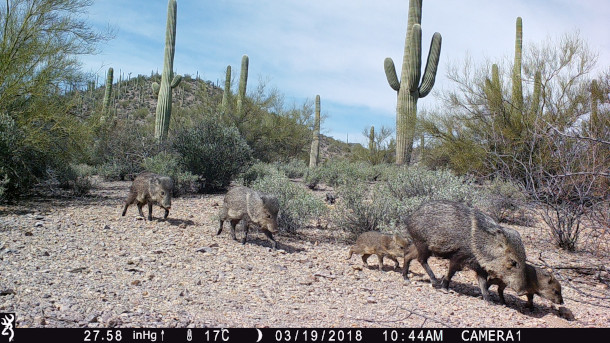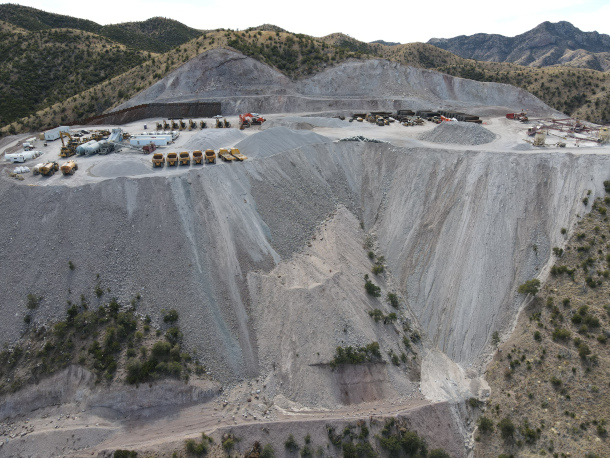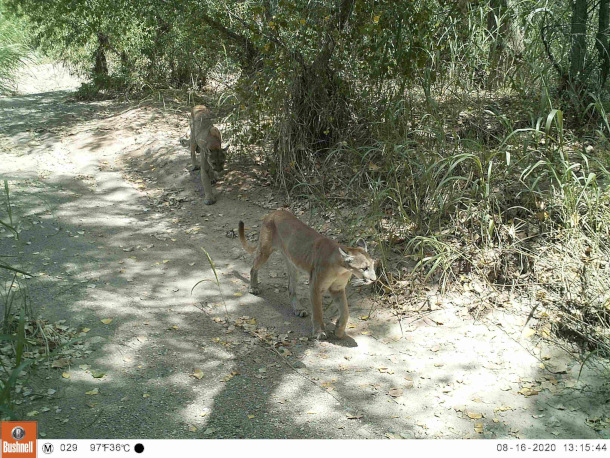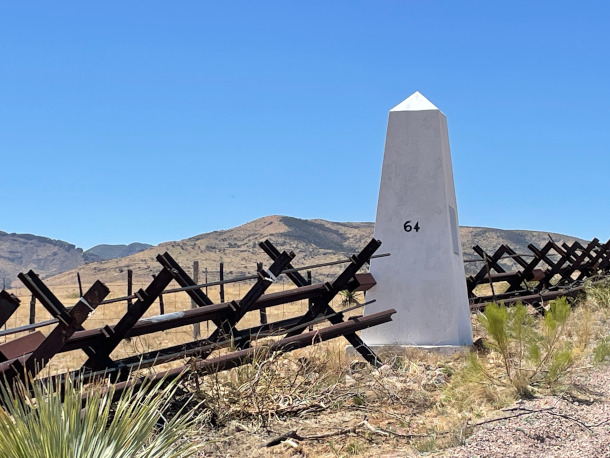Trump’s Zombie Border Wall
Air Date: Week of March 25, 2022
The “heartland of North America,” where Neotropical and temperate zones meet at the US-Mexico border, is home to animals like the American pronghorn (Antilocarpa americana). (Photo: Myles Traphagen, Wildlands Network)
President Biden campaigned on a pledge to not build another foot of the wall along the US-Mexico border, but construction has recently resumed to the dismay of some ecologists. Myles Traphagen, conservation biologist and Borderlands Program Coordinator for Wildlands Network joins Host Bobby Bascomb to talk about how the construction is threatening crucial habitat in the borderlands region.
Transcript
CURWOOD: It’s Living on Earth, I’m Steve Curwood.
BASCOMB: And I’m Bobby Bascomb.
The Trump administration spent roughly 15 billion dollars to build some 455 miles of wall along the US border with Mexico. President Biden campaigned on a pledge to end construction and vowed to not build another foot of the wall. But construction has recently resumed to the dismay of many ecologists in the region.
[SFX BIRD SOUNDS]
BASCOMB: Far from the barren desert one might think of, much of the borderlands are teeming with biodiversity.
[SFX BIRD SOUNDS]
BASCOMB: Myles Traphagen is a conservation biologist and Borderlands Program Coordinator for Wildlands Network. He notes the US Mexico border is a crucial habitat for countless iconic species.
TRAPHAGEN: It's actually one of the most rich biodiverse places on the North American continent. You know, when I hear the term Borderlands, I'm thinking less that it's the border, but rather it's the heartland of North America. And what makes this area unique is that it's the meeting ground of the Neotropics and the temperate zones. So what that means in layman's terms is that Southern species such as the Jaguar and the ocelot and the javelina, and the coatimundi, they all reach their northern limits in this part of the world. And then iconic North American temperate species such as the black bear, they reach their southern limit. So in this region, you have this merging of these different biotic communities. And that's what makes this area extremely biodiverse.
BASCOMB: Well, on the campaign trail, President Biden said he would not build another foot of the wall once he was elected. To what degree has he kept that pledge?

With only four inch gaps in between the steel bollards, these thirty foot “pedestrian fences” in Arizona, New Mexico, and California only allow for very small animals to pass through. (Photo: Myles Traphagen, Wildlands Network)
TRAPHAGEN: Well, it was looking pretty good for about a year. And fairly recently, they began border wall construction in South Texas in the McAllen area. And this is sort of undercover of levee construction, because you know, they have flood zones down there. But um, you know, from all accounts, the levees were intact, and there were no existing problems with them. And so now they're building concrete levee walls. And compared to the steel bollard walls that we have here in Arizona, California and New Mexico, a concrete levee wall is about the most extreme impermeable barrier you could apply to impeding wildlife movement. Not much can really pass through the steel bollards here. These are 30 feet tall. And they have six inch steel bollards, which are essentially six inch diameter, cold rolled steel. In between each one of these beams is a four inch gap. So nothing larger than a skull size of four inches would be able to pass through there. Maybe a Cottontail rabbit could fit through, lizards and snakes and things like that. But when you have a concrete wall, you know, nothing can pass through that. So it's really unfortunate that they have started that construction. And then recently, they just announced last month that they are going to be filling in the gaps that were not completed here in Arizona, New Mexico, and California. And the really difficult part of this is that these existing gaps are acting as wildlife corridors. They facilitate movement. And if you go down to the border and visit these locations, you see so many tracts of deer, Javelina, mountain lions, all passing through these small gaps, which may be you know, ranging from two meters to thirty meters wide. So if they fill in these gaps, that's really gonna be devastating for wildlife in the region, because they will no longer be able to migrate back and forth in their ancestral homes. In an arid region like this water sources are few and far between and they change seasonally. So generations of animals have been born into places where they've learned the terrain, and where to go throughout the season. And now we've cut that off and altered that ecological process in a matter of two years time.
BASCOMB: Yeah, it's hard to adapt to something like that. Well, why are these gaps there to begin with, and why now the need to fill them in?
TRAPHAGEN: Well, the construction crews were working towards each other, that seemed to be a strategy is to divide up the crews and see who could build fastest. And so some of these meeting grounds, they had not matched up things perfectly. The engineering, you know, was not done very well. In other cases, they hadn't figured out how to deal with the hydrological engineering. So essentially, they were making it up as they were going along. So a lot of these places were just left there, and they assume that they would just go back and figure it out. And so that's what's gonna happen now is that they're gonna go back and basically fix what they didn't have a good design for to begin with.
BASCOMB: But I mean, President Biden said he wasn't going to build another foot of the border wall, and it sounds like this is many, many feet, you know, two meters at six feet at a minimum for some of these gaps.

This family of javelina, also known as collared peccary (Pecari tajacu) in the Sonoran Desert of Pima County, Arizona, are among those animals that are prevented from traveling to historic water sites due to border wall construction. (Photo: Myles Traphagen, Wildlands Network)
TRAPHAGEN: It is. And you could take one location and say Okay, we're going to add five miles of border wall in a location that may not be as critical to wildlife as one location. And so some of these places where there might just be, you know, a two, three, four meter gap in the wall is weighted a lot more heavily, because it occurs in a place that's really crucial to wildlife migration.
BASCOMB: Well, from what I understand, at the end of 2021, the Customs and Border Protection authorized funds for working along the border, and you know, that we've already talked about filling in these gaps, but that work is also supposed to include things like cleaning up abandoned construction sites and repairing erosion. Can you tell us more about that?
TRAPHAGEN: Okay, so the remediation plan. The plan basically, is to support the border wall infrastructure, and that includes the patrol road, cattle guards, fences, and making sure that places don't erode and undercut the border wall, but none of it is really addressing the environmental concerns. They say that they are going to provide wildlife passageways along these some stretches of border wall. And when I first read it, they said it was eight by eleven. And I thought, okay, you know, eight feet by eleven, that'd be great. But no, it turns out, it was eight by eleven inches. So you're talking the size of a piece of paper and smaller than the standard doggie door you would buy at PetSmart. So to believe that 50 of these wildlife passageways along a span of 455 miles of border wall is going to accomplish the goal of allowing safe wildlife passage is completely absurd.

Mountaintop removal in the Coronado National Forest in Arizona has drastically altered the natural landscape and devastated unique ecosystems. (Photo: Myles Traphagen, Wildlands Network)
BASCOMB: Now, the Trump administration used the REAL ID Act of 2005. And that allowed them to basically move forward with wall construction in a way that ignored dozens of environmental laws. Can you tell us more about that, please, and to what degree is President Biden still leaning on the REAL ID Act to continue the work there?
TRAPHAGEN: Well, the REAL ID Act is unique in American legislation. So they enacted this in 2005. And there's a provision that allows the Secretary of the Department of Homeland Security to waive all laws for the construction of border barriers. And there's been upwards of around 60 laws waived for border wall construction. This includes the National Environmental Policy Act known as NEPA, the Endangered Species Act, the Safe Water Act, the Wilderness Act, the native Graves Protection Act, Bald Eagle Protection Act, I mean, the list goes on.
BASCOMB: And we talked earlier about the Biden administration constructing you know, these new levees and filling in the gaps in the wall. Is the REAL ID Act still in place? Is that what they're relying on? Or is it no longer applicable?

Mountain lions in the San Bernardino National Wildlife Refuge are too large to pass through the pedestrian fences erected along the Southern border. (Photo: Myles Traphagen, Wildlands Network)
TRAPHAGEN: Unfortunately, the waivers are still in place. And so for each segment of a border wall project, a waiver is issued in the Federal Register. We were hoping that the waivers would be rescinded. But they have not been. They still have the ability to go in there and do whatever they want without having any congressional oversight with having no environmental impact studies done. And that's just simply unacceptable in the American system of government, where we have been a world leader in conservation and careful review of how we treat our land and how we implement public works projects.
BASCOMB: Well, President Biden has said that he won't actually tear down the wall that was built in the previous administration. And as we talked about, he's actually filling in some gaps. But what do you think at this point should be done to mitigate the damage to wildlife?
TRAPHAGEN: Well, we need to convert these walls to vehicle barriers. There's a couple different types, and the one that's the most well known is called the Normandy barrier. And those are basically those x's constructed of, they used old railroad tracks. That still allows animals to pass through because there's sufficient gap size underneath them, for animals to get through. In fact, just a couple of weeks ago, I was down on the border in New Mexico, and a big mule deer, you know, was going down the road and I observed it jump right over the border, the Normandy barrier, that was there. That is a fundamentally different structure in terms of how it affects the environment than the 30 foot walls. And in fact, not only do they not allow wildlife to pass through, they also are really dangerous to people who are attempting to cross these fences. So these border walls are killing machines on every level and in a humane and just society, we can't allow this to go on.

Vehicle barriers, which have larger gaps than pedestrian fences and concrete levees, may allow more animals to migrate successfully along the border. (Photo: Myles Traphagen, Wildlands Network)
BASCOMB: Myles Traphagen is a conservation biologist and Borderlands Program Coordinator at Wildlands Network. Myles, thank you so much for your time today.
TRAPHAGEN: Thank you so much, Bobby, and I really appreciate that Living on Earth has taken an interest in this important topic.
BASCOMB: We reached out to US Customs and Border Protection and a spokesperson replied via email. “During the environmental planning process for (the) border barrier, CBP coordinated closely with the Department of Interior (DOI) and U.S. Fish and Wildlife Service (USFWS) to identify potential impacts to wildlife and approaches that support both wildlife migration and border security to the greatest extent possible.” To read their full statement visit the Living on Earth website loe dot org.
Full US Customs and Border Protection statement by a CBP spokesperson
"During the environmental planning process for border barrier, CBP coordinated closely with the Department of Interior (DOI) and U.S. Fish and Wildlife Service (USFWS) to identify potential impacts to wildlife and approaches that support both wildlife migration and border security to the greatest extent possible.
These elements include the installation of small wildlife passages and opening of flood gates. CBP has been actively engaged with its interagency partners, including various bureaus of the Department of the Interior and the Department of Agriculture, regarding the development of potential long-term environmental mitigation measures to include wildlife use and movement studies."
Links
Wildlands Network | “The Border Wall in Arizona and New Mexico–July 2021”
Living on Earth | “How the Border Wall Could Harm Wildlife”
Living on Earth | “Science at Risk at the Border”
Living on Earth | “The Border Wall’s Wildlife Impacts”
Living on Earth | “Exploring the Parks: Cactus and Snow in the Desert Sky Islands”
Living on Earth wants to hear from you!
Living on Earth
62 Calef Highway, Suite 212
Lee, NH 03861
Telephone: 617-287-4121
E-mail: comments@loe.org
Newsletter [Click here]
Donate to Living on Earth!
Living on Earth is an independent media program and relies entirely on contributions from listeners and institutions supporting public service. Please donate now to preserve an independent environmental voice.
NewsletterLiving on Earth offers a weekly delivery of the show's rundown to your mailbox. Sign up for our newsletter today!
 Sailors For The Sea: Be the change you want to sea.
Sailors For The Sea: Be the change you want to sea.
 The Grantham Foundation for the Protection of the Environment: Committed to protecting and improving the health of the global environment.
The Grantham Foundation for the Protection of the Environment: Committed to protecting and improving the health of the global environment.
 Contribute to Living on Earth and receive, as our gift to you, an archival print of one of Mark Seth Lender's extraordinary wildlife photographs. Follow the link to see Mark's current collection of photographs.
Contribute to Living on Earth and receive, as our gift to you, an archival print of one of Mark Seth Lender's extraordinary wildlife photographs. Follow the link to see Mark's current collection of photographs.
 Buy a signed copy of Mark Seth Lender's book Smeagull the Seagull & support Living on Earth
Buy a signed copy of Mark Seth Lender's book Smeagull the Seagull & support Living on Earth

